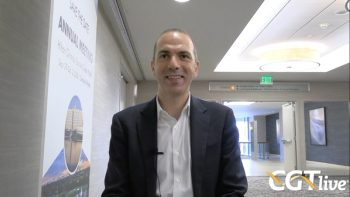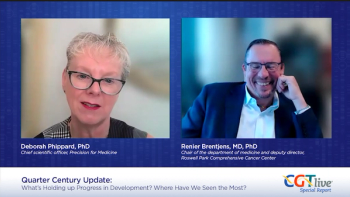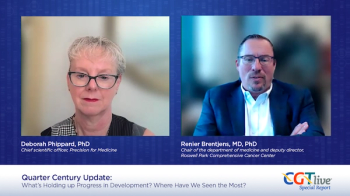
SGT-001 Shows Promising Functional Improvements in DMD
SGT-001 elicited promising improvements in functional and biomarker end points for patients with Duchenne muscular dystrophy.
The AAV9-mediated microdystrophin gene therapy SGT-001 elicited promising improvements in functional and biomarker end points for patients with Duchenne muscular dystrophy (DMD), according to updated findings from the ongoing phase 1/2 IGNITE DMD trial presented at the 2021 MDA Virtual Clinical & Scientific Conference.
In data from 6 patients treated with SGT-001 at high and low doses, there was an improvement in North Star Ambulatory Assessments (NSAA) compared with a delayed treatment control group (n = 3) and historical controls. Moreover, average 6-minute walk test (6MWT) distance was above 30 meters in both cohorts compared with a decline of 8.5 meters in the control group. Additionally, biomarker findings showed wide distribution of microdystrophin-positive muscle fibers and promising creatine kinase (CK) findings, suggesting disease stabilization with SGT-001.
“IGNITE DMD has demonstrated some meaningful evidence of benefits in multiple outcome measures across a wide age range of patient,” principal investigator Barry Byrne, MD, PhD, associate chair of Pediatrics and Director of the Powell Gene Therapy Center at the University of Florida, said during a presentation of the findings. “Some things are not easily captured in time function tests or quality of life measures. One of the most significant is that boys with Duchenne rarely run. It has been very rewarding to hear from families when these new-found abilities to run and other skills have led to the ability to participate in sports or even ride a bike. These moments are a really important part of childhood.”
Data presented at the meeting from the phase 1/2 study were from 9 patients aged 4 to 17 across 2 cohorts that analyzed different doses of SGT-001. In cohort 1, 3 patients were randomized to low-dose SGT-001 at 513 vg/kg or to a delayed treatment control group (n = 3). In cohort 2, 3 patients received SGT-001 at a higher dose of 214 vg/kg. The study has since been adapted to be an open-label, non-randomized trial and the control arm has been closed.
For functional outcomes, data were available for 2 patients each in the low-dose and control arms and for all 3 in the high-dose cohort. The mean change in NSAA total score at 1-year in the control arm was -1 and -7 compared with -3 and +5 in the low-dose cohort. By month 24, both patients in the low-dose cohort showed an improvement in NSAA total score (+1 and +5). In the high-dose cohort at 12 months, NSAA total score was +1, -1, and +1. Longer-term data were not yet available in this group. “It will be important to continue to examine the entire cohort over time,” Byrne noted.
For 6MWT, total distance declined in the control arm at 1-year compared with baseline by -8 and -9 meters. In the low-dose cohort, distance walked at 1-year increased from baseline by +12 and +62 meters (average, +37). At 2 years, this was +62 and +133 meters (average, +97.5). In the high-dose cohort, distance walked increased by +12, +52, and +85 meters at 1 year (average, +50).
Improvement in pulmonary function tests were observed with SGT-001 compared with natural history at 1-year, Byrne noted. Data for this end point were available for all 9 patients. Improvements in forced vital capacity (FVC) were seen in most patients treated with SGT-001. In the low-dose group, FVC at 1-year was -2.4%, 5.3%, and 8.9%. In the high-dose group, FVC was 3.1%, 10.2%, and 36.7% at 1 year. In the control arm, mean percent change in FVC at 1-year was -7.6%, -9.6%, and -15.0%.
In cohort 2, there was wide distribution of microdystrophin-positive muscle fibers at 90 days, with distribution ranging from 10% to 70%. By western blot analysis, the average microdystrophin level at 90 days was within 10% of normal dystrophin levels (range, ~5% to 17.5% of normal). Additionally, there was a 55% decline in CK levels 1 year after infusion of high-dose SGT-001, from an average baseline of 13,288 to 5908 following treatment. In cohort 1, a CK decrease was not observed. Patients went from an average baseline CK of 7774 to an average of 16,654 at 1 year (166% increase).
"There is a meaningful decrease in CK for patients in the high-dose group. While this biomarker can be variable, the average sustained decline of about 50% in the high-dose cohort seen after 1 year suggests improved integrity of the muscle fibers and a potential protective effect of the treatment," Byrne said.
The most common drug-related adverse events (AEs) were nausea (100%), vomiting (83%), and fever (67%). Less common events included cytokine release syndrome, generalized edema, hepatotoxicity, systemic inflammatory response, and thrombotic microangiopathy. These AEs are common in other systemic gene therapy studies, Byrne said. The most common treatment-related laboratory abnormalities included thrombocytopenia, increased fibrin D dimer, increased soluble C5b-9, increased LDH, and proteinuria.
There were 4 serious AEs in 3 of the 6 patients, 1 of which was deemed unrelated to SGT-001 and 2 were related to the activation of the soluble C5b-9 terminal complement system. The other serious AE was a case of immune hepatitis 4 weeks post treatment, which resolved rapidly with corticosteroids. "No new drug-related safety findings have been identified post-infusion in these 6 patients, between 17 and 37 months of follow up," Byrne said.
"The IGNITE DMD study included patient-reported outcome measure from 4 motor function domains from the Pediatric Outcomes Data Collection Instrument, or PODCI," said Byrnes. "Consistent with what would be expected with natural history data, the 2 patients in the control cohort had declines in scores in all 4 domains. In contrast, patients in the high-dose cohort had significant improvements in all 4 domains and the patients in the low-dose cohort improved in a minority of domains as well."
There have been several amendments to the IGNITE DMD study protocol, in response to serious AEs that occurred earlier in the study. Some of these concerns led to a clinical hold on the trial in the middle of 2020. The study subsequently resumed in October 2020. “The changes included a pretreatment regimen with complement inhibitors, transient increase in steroid use, and a second-generation manufacturing process to reduce the total viral capsid level per kilogram,” Byrne said.
Since reopening the study in October, an additional patient was enrolled and treated in the high-dose SGT-001 treatment arm. At this point, safety assessments on the seventh patient treated with SGT-001 have been promising and the patient has only experienced transient adverse events, according to Solid Biosciences, the company developing the gene therapy.
“We are encouraged with the successful resumption of dosing in the IGNITE DMD trial under our amended clinical protocol and using SGT-001 manufactured with a second-generation process," Ilan Ganot, chief executive officer, president and co-founder of Solid Biosciences, said in a statement. “We look forward to continuing to dose patients and reporting clinical outcomes from additional patients in the second half of 2021.”
Newsletter
Stay at the forefront of cutting-edge science with CGT—your direct line to expert insights, breakthrough data, and real-time coverage of the latest advancements in cell and gene therapy.











































